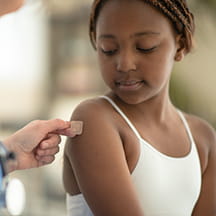After an increase in behavioral health issues presenting in the emergency room, providers at Cohen Children’s Medical Center in Queens, New York, realized something needed to change.
It was clear to Vera Feuer, MD, director of Pediatric Emergency Psychiatry and Behavioral Health Urgent Care, that patients were not receiving interventions early enough, likely due to a lack of identification and access. If patients weren’t receiving what they needed in their community, it was up to the hospital to fill the gap, even if that meant trying something new.
“Let’s write a different story,” Feuer said. “Let’s engage in a different way.”
A different way
In January 2020, Cohen Children’s developed a behavioral health care model centered on schools, with one behavioral health center serving as a hub for multiple districts. It now has three centers serving 36 districts, including 284 schools and 200,000 students across Nassau and Suffolk Counties in Long Island, New York.
“This hub-and-spoke model works really well, especially with the shortage of child psychiatrists,” Feuer said. “Though schools don’t have their own psychiatrist, they always have access to one.”
Staffed by board-certified child and adolescent psychiatrists, licensed mental health counselors, and care coordinators, the centers provide psychiatric assessments and short-term crisis care to any student referred to them. Half of the referrals come from school staff while the others come directly from families or health professionals in the community. “Anybody can refer. That's one big benefit of the program. Though it's a school program, it still is accessible for the community directly, Feuer said.
Referrals are triaged, and appointments are scheduled within days or on the same day if needed. Every patient sees the child psychiatrist, and care coordinators connect the student with ongoing care. “These care coordinators will provide support for as long as it takes,” Feuer said. Within six weeks, 75% of the students are connected with a long-term provider. Within three months, 95% are connected. For those waiting for long-term placement, the center provides bridge therapy and crisis medication management. The hospital is developing more short-term services for high-risk kids, such as those with suicidality and those transitioning from an inpatient setting.
“The evidence tells us that robust school mental health systems work on multiple tiers of a pyramid,” Feuer said. “Everybody in the school needs prevention and education. Some kids need consultation and connection to services. Others, at the top of the pyramid, need immediate clinical care or more intensive services, like hospitalization. We're able to meet the needs at every level.”
The hospital has recently added a school avoidance program, helping students return to school rather than defaulting to home instruction. “It is requested very often and has been very successful,” Feuer said. The program involves coaching parents, working with students, and planning transition accommodations with the school team.
Community and collaboration
The behavioral health program is guided by an advisory board that includes school social workers, teachers, parents, and even students. And everything is done in conversation and collaboration with the school districts.
“Even though we work with many districts, we still have a very close collaborative relationship. And that’s why our services have grown tremendously,” Feuer said. “The most exciting part for me has been the ability to create accessible care for families even if they don't have insurance or if they have difficulty with transportation. We're problem solving together with the districts to figure out a way to get them the care that they need.”
Additional school services
In addition to the behavioral health centers, all 46 school districts have access to a host of other services, including:
- Community education. Webinars are available for parents on various child and adolescent health and well-being topics.
- Professional development. Ongoing trainings are offered to hospital staff, teachers, and paraprofessionals, including 40 CEUs worth of classes, many focusing on mental health topics.
- Direct-to-student education. Hospital staff or health educators visit classes to educate students on various topics, including mental health.
- Student advocacy program. High school students receive education on leadership, advocacy, and Mental Health First Aid. The program includes a peer-led mental health project for the school.
Results
Feuer said it’s difficult to measure the outcomes of a program like this because it's multitiered and far-reaching. But the hospital does measure a variety of outcomes and provides schools with de-identified data on their students.
Some measurable outcomes include:
- 60% decrease in referrals to the emergency room on average.
- 95% connection to ongoing care within three months.
- 90% school district satisfaction and high family satisfaction, based on surveys.
“Going ‘upstream’ into the community and partnering with schools to advance the mental health of children and families has been a very promising and exciting model to allow for our mission of early identification, creating access, and helping address disparities and stigma,” Feuer said.
Feuer's presentation was part of the session "Bringing Mental Health Care in Schools" at Children's Hospital Association's 2024 Transforming Quality Conference.


